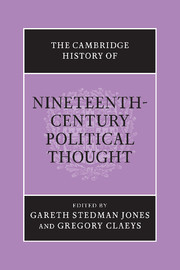Book contents
- Frontmatter
- Contents
- Contributors
- Acknowledgements
- Introduction
- I Political thought after the French Revolution
- 1 Counter-revolutionary thought
- 2 Romanticism and political thought in the early nineteenth century
- 3 On the principle of nationality
- 4 Hegel and Hegelianism
- 5 Historians and lawyers
- 6 Social science from the French Revolution to positivism
- 7 Radicalism, republicanism and revolutionism
- II Modern liberty and its defenders
- III Modern liberty and its critics
- IV Secularity, reform and modernity
- Biographies
- Bibliography
- Index
7 - Radicalism, republicanism and revolutionism
From the principles of ’89 to the origins of modern terrorism
from I - Political thought after the French Revolution
Published online by Cambridge University Press: 28 July 2011
- Frontmatter
- Contents
- Contributors
- Acknowledgements
- Introduction
- I Political thought after the French Revolution
- 1 Counter-revolutionary thought
- 2 Romanticism and political thought in the early nineteenth century
- 3 On the principle of nationality
- 4 Hegel and Hegelianism
- 5 Historians and lawyers
- 6 Social science from the French Revolution to positivism
- 7 Radicalism, republicanism and revolutionism
- II Modern liberty and its defenders
- III Modern liberty and its critics
- IV Secularity, reform and modernity
- Biographies
- Bibliography
- Index
Summary
Introduction
Modernity has been quintessentially defined by the revolutionary impulse, and our judgement, whether laudatory or critical, of the French Revolution of 1789. In the nineteenth century it would be associated with virtually all radical, republican and revolutionary movements, and, by the end of the First World War, the overthrow of many of the leading crowns of Europe. Yet the course of events which produced the overthrow of Louis XVI was not at its outset inevitably anti-monarchical, and would indeed culminate in imperial dictatorship. In association with American independence, however, the idea of revolution came to be identified with the principle of popular sovereignty as such. It was also linked to the explosion of nationalist aspirations which became definitive of the period, as well as to the causes of reaction and the creation of modern conservatism in the works of Burke, Bonald and others. If the British model of limited, constitutional monarchy resting on the principle of the rule of law was central to eighteenth-century reformers elsewhere, thus, it was increasingly supplanted during the nineteenth century by the ideals which emerged from the revolutions of 1776, 1789 and 1848. ‘Revolution’ itself, which had once meant a restoration or rotational return to previous conditions, came to mean the violent overthrow of established regimes in the name of popular sovereignty, ethnic and national self-assertion, or both; and the conscious framing according to the principles of reason of an edifice hitherto regarded largely as a natural, organically derived and divinely inspired order. To its opponents it was also often linked to an obsessive demand for individual autonomy, the growth of commercial and societal individualism, and the wish to break from traditional forms of authority, particularly paternalism and religion.
- Type
- Chapter
- Information
- The Cambridge History of Nineteenth-Century Political Thought , pp. 200 - 254Publisher: Cambridge University PressPrint publication year: 2011
- 2
- Cited by



